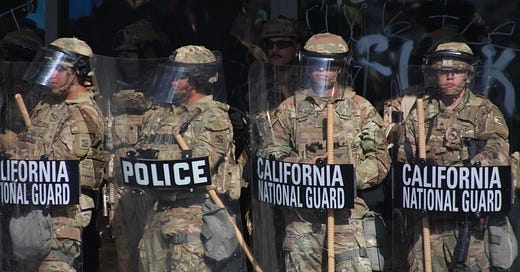Make way for the 10th Amendment “anti-commandeering principle”
One state’s ceiling is another fed’s floor
After a dizzying day in the federal courts in California, we’re back where we started, with the California National Guard still—and again—under the control of the federal government.
Judge Chuck Breyer’s meticulous 36-page opinion was administratively stayed at the end of the evening by a 9th Circuit motions panel, which set an argument on the merits for next Tuesday.
That effectively scuttled Breyer’s yeoman’s work. After setting a lightning-quick briefing schedule and holding an hour-plus hearing, Breyer disappeared into his chambers and pounded out a 36-page opinion concluding that the Administration’s invocation of Title 10 §12406 power was flawed for two reasons.
The first reason is the most important as we proceed up the ladder of the federal courts. Judge Breyer rejected the Administration’s position that courts have to completely defer to the President’s assessment of whether a “rebellion” is underway, so as to trigger §12406. That question of deference will be front and center moving up the federal court ladder, and look to these pages for more discussion of it.
Breyer added a second reason why Trump’s order was flawed: the 10th Amendment. In brief, Breyer reasoned that the states—not the federal government—have the general police power, and given the statutory weakness of the “rebellion” argument, the feds in effect were trenching on authority that the Constitution reserves to the states.
That ruling was one of several very recent decisions that have brought to the fore a new important player in the doctrinal challenges to Trump’s various overaggressive power grabs: the 10th Amendment. Because I think the 10th Amendment’s turn on the stage is about here, I want to spell out for everyone some of its key principles that are likely to play prominent roles in upcoming cases.
Trying to follow Trump’s series of outlandish and lawless actions for many of us entails taking on a new legal vocabulary: previously obscure phrases, such as “unitary executive,” “federal habeas corpus,” and “temporary restraining order,” now show up in everyday discourse.
As the Trump administration sets its sights on steamrolling state power—as in Los Angeles—or arresting state officials—as with Judge Hannah Dugan—prepare to add a new entry to your Trump glossary: the 10th Amendment, and its related concepts of federalism and the prohibition on commandeering.
The 10th Amendment has undergone a dramatic doctrinal transformation in the last 30 years, under the impetus of conservative justices on the Supreme Court. The provision itself is simultaneously bland and delphic. It reads: “The powers not delegated to the United States by the Constitution, nor prohibited by it to the States, are reserved to the States respectively, or to the people.”
Is this merely stating a “truism,” as the Court famously put it in a 1941 case that stood as the basic exposition of the provision for 50 years? Is it saying that if the Framers didn’t address it, the default is that the powers belong to the states, who were the constituents of the new federal government? Is it rather stating a populist principle that all power not specifically given to the new government belongs to the people? What would it mean exactly to belong to the people? And what of that odd “respectively” between the two terms?
Don’t worry—this is not the place for an excavation of the cryptic recesses of the amendment. Suffice to say it lay around adding very little to constitutional law until the 1990s, when the Court began to issue a series of opinions interpreting the 10th Amendment as a forceful shield against even modest federal intrusions on state sovereign functions.
In 1992, the Court, breaking new ground, struck down a federal law that sought to require the states—if they failed to provide for disposal of waste generated within their borders—to “take title” to the waste (i.e., assume ownership and liability). The Court articulated what has come to be known as the “anti-commandeering” principle derived from the 10th Amendment. As the Court put it, “The Federal Government may not compel the States to enact or administer a federal regulatory program.”
In subsequent cases, the Court has been very strict in its policing of the boundaries set by the anti-commandeering principle. It has forbidden Congress from compelling state governments to undertake even modest steps in support of federal policies. Printz v. United States, for example, was a challenge to a temporary and fairly modest requirement that state and local law enforcement officers perform background checks on handgun buyers before the federal NICS system went online. Writing for a 5–4 majority, Justice Scalia held that the provision violated the anti-commandeering principle because the federal government was requiring steps—however minor—to implement and enforce federal law.
More recently, in Murphy v. NCAA, the Court struck down a federal law that prohibited states from authorizing sports gambling. The law didn’t require the states to do anything whatsoever; it merely prohibited them from changing their own laws. But the Court, per Justice Alito, perceived a commandeering of state legislative processes, which made the law run afoul of the 10th Amendment.
Flash forward to the present, as the Administration’s aggressive anti-immigration campaign puts them nose to nose with certain state officials. The federal government’s position is clear: it is enforcing federal immigration law, and state officials had better get out of the way or suffer the consequences (including arrest and federal criminal charges).
But what the feds call impeding, state officials may call doing their official duties; and what the feds call enforcing federal immigration law, the states may call trenching on state sovereignty. We've seen two vivid examples of this sort of rhetorical and practical standoff in the last week.
The first is in the case of Judge Hannah Dugan, the Wisconsin state judge whom the feds have charged with obstructing a federal proceeding and concealing someone to prevent their arrest. She has moved to dismiss her case on 10th Amendment grounds, arguing that the prosecution "reaches directly into a state courthouse, disrupting active proceedings, and interferes with the official duties of an elected judge." The arrest and prosecution are nothing less than a “violat[ion of] Wisconsin sovereignty.”
The Administration’s response first tries to dilute the substance of the anti-commandeering principle. It hearkens back to the idea that the 10th Amendment doesn't have any independent force; rather, it is "essentially a tautology.” So long as Congress acted properly under its Article I powers, the 10th Amendment has nothing to add to the analysis.
The papers in the Dugan case paint opposing pictures—and backdrops—of the critical events. Dugan sets the stage in her courtroom and assails the DOJ for trying to tell her how she has to manage her own courtroom—in other words, for trying to commandeer her official state functions. DOJ counterposes a different setting and a different characterization. It argues that "the immigration enforcement that Dugan attempted to obstruct was lawful—in a public space—and lay wholly in the jurisdiction of the federal government.”
Another class of cases setting up this showdown over the 10th Amendment involves federal efforts to thwart so-called sanctuary cities. Those jurisdictions refuse to cooperate with certain federal efforts to enforce immigration laws. For example, they may prohibit their police from asking residents about their immigration status, or refuse to share information with Immigration and Customs Enforcement (ICE).
In the eyes of Pam Bondi, those jurisdictions are scofflaws who, in the words of her directive to the field, "unlawfully interfere with federal law enforcement operations." The directive made it a priority for the department to pursue enforcement actions against sanctuary cities or states that do not comply with the federal government’s immigration efforts. Bondi wrote, “State and local actors may not impede, obstruct, or otherwise fail to comply with lawful immigration-related directives.”
In the first test case of the Bondi directive, the Department sued to bar Illinois, Chicago, Cook County, and the Cook County Sheriff from using local laws that protect migrants to hamper law enforcement. The Department argues that the sanctuary policies “interfere with and discriminate” against the federal government’s immigration enforcement. Cook County says their policies only prevent local law enforcement from assisting ICE in tracking down undocumented immigrants in civil cases, and that they do not impede federal criminal law enforcement.
DOJ has asked for a preliminary injunction to keep Cook County from enforcing its sanctuary laws, while the County is seeking to dismiss the case, arguing it’s in full compliance with the Constitution.
It’s the same dichotomy: the feds say Cook County is “impeding” federal law enforcement; Cook County responds it’s simply not providing assistance, and that’s its constitutional right. Whichever viewpoint wins out will likely drive the determination of who’s violating the Constitution.
Finally, we have the challenge of over 12 municipalities, led by San Francisco, to Trump’s Executive Order 14159. Trump issued the order, which seeks to deny federal funding to local jurisdictions with sanctuary laws. The plaintiffs challenged the order, along with Bondi’s directive enforcing it, arguing, among other things, that it violated the 10th Amendment by trying to force local officials to cooperate with federal immigration arrests.
Judge Orrick of the Northern District of California entered a preliminary injunction barring enforcement of the order. The case is now on appeal in the 9th Circuit.
We know the federal government is spoiling for a confrontation with state and local authority, particularly surrounding immigration enforcement. The head-butting in Los Angeles these last few days is almost certainly not the end of the direct encounters between federal and state authorities. Picture a collision exactly on the 50-yard line: each side insists it’s the other guys who encroached on their territory. That may be a rough approximation of some of the cases that will make their way to the courts as the Administration tries to throw its weight around in every nook and cranny where undocumented migrants might be found. Legitimate federal enforcement or illegitimate commandeering—and what precisely is the line between them? And coin flips to decide aren’t allowed.
Talk to you later.







Harry thanks for your great insights and expertise. You always take these ugly bags of snakes and lay them out straight.
Is it just my perception that the only places that are being over run by trumps use of troops are States that have Democratic legislators and governors?